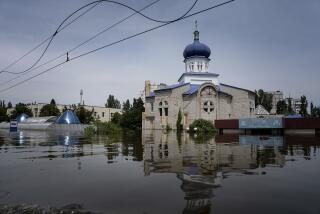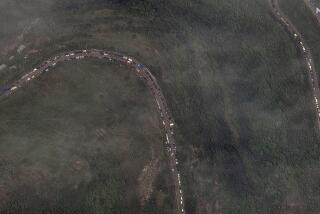Pollution Takes Heavy Toll on Kazakstan
- Share via
ALMATY, Kazakstan — The doctors at the National Rehabilitation Center put the two young boys through the gamut of tests and examinations.
Then they told the mother their findings: Hepatitis. Bronchitis. Malnutrition. The 3-year-old, Nurkhan, also has cerebral palsy. Nurkin, 2, suffers hypertension.
“No one ever told me this. I had no idea,” said Achkendzhe Shiderbayeva, whose sons are among a lucky few from the Aral Sea region to get slots at a children’s sanatorium outside Almaty, capital of this former Soviet state.
The boys’ illnesses are common for children from the ecological disaster area of the Aral Sea, an inland sea in Central Asia that has been polluted and shrunken by over-irrigation and pesticide use for cotton farming.
According to a United Nations report this year, the illness rate has skyrocketed for infants in Kzyl-Orda, biggest city in the Aral Sea region. In 1990, it was 1,485 ailments, including colds and other common illnesses, per 1,000 children. By 1994, it was 3,134 per 1,000 youngsters.
Especially common are respiratory, infectious and parasitic diseases. Blood diseases and birth defects also have increased, the report said.
“These children won’t die now, but they also won’t live to see 60,” said Dr. Zaira Mazhitova, director of the National Rehabilitation Center.
Life expectancy in the Aral Sea region is 59.5 years, and most residents can count on both hands the number of relatives, friends and neighbors who died in their mid-40s.
The area’s problems stem from Soviet efforts to turn the region into a vast plantation, especially for cotton. Heavy use of pesticides and other chemicals contaminated the sea and ground water, as did salt blown from the evaporating sea.
Huge irrigation networks diverted so much of the Amu Darya and Syr Darya rivers that nearly all of the water flow to the sea was cut off. Since 1960, it has lost two-thirds of its volume and its surface shrank from 25,600 square miles to just 11,000. In some spots, the shoreline receded 90 miles.
Scientists say the poor quality of drinking water due to high salt and chemical content is the root of the high incidence of diseases.
The demise of the Aral Sea is not limited to the bordering countries of Kazakstan and Uzbekistan, but affects all of Central Asia.
Sand blowing from the exposed seabed is saturated with pesticides and salts. Hundreds of miles away, it covers the ground like toxic snow. Desertification has caused temperatures to soar and altered plant and animal life.
But the greatest problems are in the immediate region, which is home to 1.5 million people, or just over 9% of Kazakstan’s population.
Until the early 1980s, most families managed to grow their own fruits and vegetables, but salinization has ruined the land.
“Last year we wanted to grow tomatoes, but they dried out. Now nothing grows,” said Shiderbayeva, who lives in the town of Dzhagaldash.
Of necessity, the regular diet is now beshbermak--a local meat dish--and bread. Fruits and vegetables are available at bazaars but are too expensive for the average family.
Water must be boiled before it is drunk. Its salt content has risen from 10 grams per liter (about a quart) in the 1960s to 40 grams per liter today, said Kakimbek Salykov, an Aral Sea expert at Kazakstan’s Committee on Water Resources.
The shrinkage of the Aral Sea also killed the region’s most important economic activity, its fishing industry. In the past, 45,000 metric tons of fish were processed a year, but the stocks have been wiped out, Salykov said.
That, along with agriculture problems, have produced an unemployment rate of 50% and prodded many people to move out, particularly ethnic Russians, Germans and Ukrainians.
Many of those who stay--primarily Kazaks who feel connected to the land cultivated by their parents and grandparents--have turned to animal breeding.
International organizations, including the World Bank, did not become involved in trying to save the Aral Sea until 1994, at the request of the five former Soviet republics of Central Asia: Kazakstan, Kyrgyzstan, Tajikistan, Turkmenistan and Uzbekistan.
About $40 million was spent over the last two years studying the problem. Now, experts estimate that it will cost about $470 million over the next few years to implement projects aimed at just keeping things from getting worse.
“There is no serious thinking that the Aral Sea will be restored to its old level of 1960,” said David Pearce, the World Bank’s representative in Almaty.
And international organizations say it may take 15 to 20 years before the water level can be stabilized.
That may be too late for the locals.
“I know many young people who have died,” said Besin Akisayeva, who also has two children being treated at the sanatorium outside Almaty. “Our children don’t have grandparents anymore. I am afraid.”
More to Read
Sign up for Essential California
The most important California stories and recommendations in your inbox every morning.
You may occasionally receive promotional content from the Los Angeles Times.










